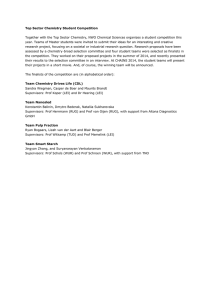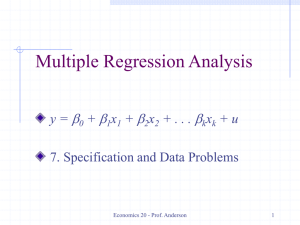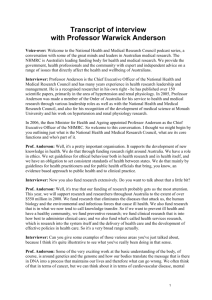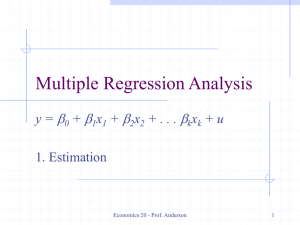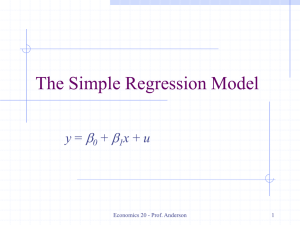Optimization
advertisement
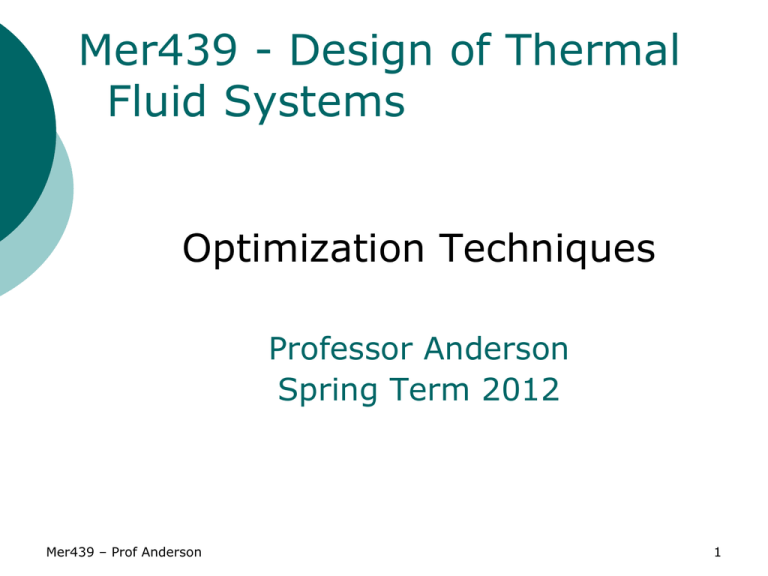
Mer439 - Design of Thermal Fluid Systems Optimization Techniques Professor Anderson Spring Term 2012 Mer439 – Prof Anderson 1 Optimization in Design Need Identified Modeling/Simulation Problem Definition Workable Design Concept Generation Optimization/ Optimal Design Concept Selection Mer439 – Prof Anderson 2 Optimization Set of all “workable” or “functional designs” (Allowed by physics, orange border) x2 * Optimal Design U(x1,x2) = Umax x1 Mer439 – Prof Anderson 3 Lingo Objective Function: represents the quantity (U) which is to be optimized (the “objective”) as a function of one or more independent variables (x1, x2, x3…) Design Variables: The independent variables (x1, x2, x3…) that the objective function depends on. Constraints: Relations which limit the possible (physical limitations) or the permissible (external constraints) solutions to the objective function. Mer439 – Prof Anderson 4 Mathematical Formulation Objective Function of n independent design variables: For U( x1, x2, x3…xn) Equality Constraints: Gi( x1, x2, x3…)=0 Find Uopt i=1,2,…,m Inequality Constraints: Hj(x1, x2, x3…) < or > Cj j=1,2,…l If n>m → An Optimization problem results If n=m → A unique solution exists…just solve all equations simultaneously If n<m → The problem is “over-constrained” no solution which satisfies all of the constraints is possible Mer439 – Prof Anderson 5 Acceptable Designs x2 Set of all “workable” or “functional designs” (Allowed by physics, orange border) H1 : X1> c1 * Optimal Design U(x1,x2) = Umax H2 : X2 < c2 Set of all “acceptable” designs. (allowed by constraints, yellow border) x1 Mer439 – Prof Anderson 6 Example Set up a mathematical statement to optimize a water chilling system. The requirement of the system is that it cool 20 kg/s of water from 13 to 8 oC, rejecting the heat back to the atmosphere though a cooling tower. We seek a system with a minimum first cost to perform this duty. Mer439 – Prof Anderson 7 Classification of Optimization Techniques Calculus based Techniques “Programming” methods Lagrange Multipliers Linear Programming Geometric Programming Search Methods Elimination Methods Exhaustive Fibonacci golden section search “Hill Climbing” techniques Lattice Search Steepest ascent Mer439 – Prof Anderson 8 The aptly named Exhaustive Search x2 H1 : X1> c1 H2 : X2 < c2 * Optimal Design U(x1,x2) = Umax Note: None of the search points exactly hits the optimum. The space between search points is known as the “interval of uncertainty” x1 Mer439 – Prof Anderson 9 Search Methods Types of Approaches Elimination Methods Hill Climbing Techniques Constrained Optimization Mer439 – Prof Anderson 10 Unconstrained Search with Multiple Variables. Mer439 – Prof Anderson 11 Lattice Search 1 3 * 2 * 4 * Mer439 – Prof Anderson * 12 Lattice Search Mer439 – Prof Anderson 13 Univariate Search Mer439 – Prof Anderson 14 Example (Univariate Search) Find the minimum value for y, where: x2 16 y x1 x1x2 2 Use only integer values of x1 and x2 and start w/ x2 = 3 Mer439 – Prof Anderson 15 The Project What exactly are you trying to optimize? → “What is your Objective Function?” What is the Absolute maximum that one would be willing to pay? → “Is there a cost inequality constraint that we can use to help limit our design domain?” What are your “design variables” ? What is the nature of your functions? (continuous / discrete) (linear/nonlinear) etc. Mer439 – Prof Anderson 16 Presentation Must Include A clear representation of your Objective Function Clear Representations of your constraints A description of your optimization methods Evidence of a Sanity Check on your proposed solution Mer439 – Prof Anderson 17






